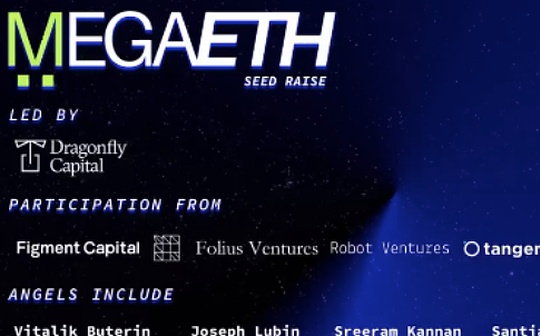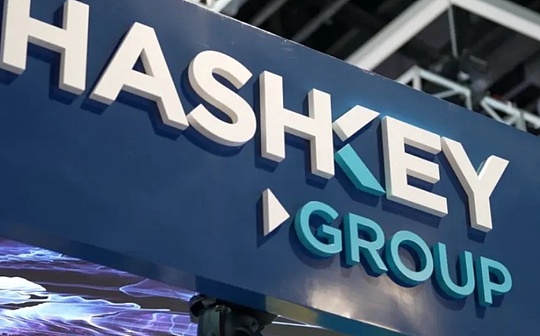
Written article: 0xjs@:
According to L2Beat data, there are currently more than 50 L2.Does the encryption market still need a new L2?
The answer is yes.Recently, an EVM L2 public chain MEGAETH came out in the crypto market, and received $ 20 million in seed wheel financing.
MEGAETH’s 20 million financing is led by encrypted VC Dragonfly Capital, Figments Capital, Folius Ventures, Robot Ventures, Big Brain Holdings, Tangent and Credible Neutral.In addition, it has received investment from Vitalik Buterin, Consensys founder Joseph Lubin, Sreram Kannan, Cobie, Karthik Talwar, Hasu, Santiago and Merts Angel Investors.

What public chain is Megaeth?What charm can still attract so many luxury investment lineups after many L2?
There are so many L1/L2, why do you need a megaeth
The advancement of the blockchain framework has greatly reduced the threshold for creating a new chain (including L1 and L2).Therefore, a large number of new public chains have recently appeared.According to L2Beat data, there are currently more than 50 L2 projects.
However, simply creating more chains does not solve the problem of scalability of the blockchain, because each separate chain still has significant restrictions on the DAPP it carried.For example, the following table shows the goal GAS and block time of the main EVM chain today.

The above table clearly shows that the existing EVM chain is facing major restrictions in several aspects.First, they all show lower transaction throughput.For example, although OPBNB stands out at a very high GAS rate of 100 mgas/s in peers, it is still dwarfed compared with the function of modern Web2 servers.As a reference, 100 mgas/s is equivalent to 650 times per second of Uniswap exchange or 3,700 ERC-20 transmission.In contrast, the modern database server has traded more than one million transactions per second in the TPC-C benchmark.
Secondly, due to scarcity of computing power, complex applications cannot be on the chain.For example, a simple EVM contract calculation is the first (n = 10) Fibonacci number consumes about 5.5 billion GAS, which will occupy the entire OPBNB chain for 55 seconds, and the calculation speed is 100 mgas/s.In contrast, the similar program written in C can complete the same task only 30 milliseconds. Using a single CPU core can increase its speed by 1833 times!Now imagine the possibility of using a multi -core processing to unlock the blockchain of another 100 times computing power.
Finally, applications that need to be a high update rate or a fast feedback cycle are not feasible within a longer outlet time.Except for Arbitrum One, all chains in the table will be updated per second or longer.However, DAPP on a complex chain like the autonomous world requires a high update rate (for example, the outlet interval is less than 100 milliseconds) to simulate real -time combat or physics.In addition, unless it can place an order or cancel an order within 10 milliseconds, high -frequency transactions on the chain are impossible.
Fortunately, these restrictions are not overcome for the EVM chain.With the advancement of technology, it is time to build a real -time blockchain to release these potential.Time blockchain is a blockchain that can be processed immediately and released the results update in real time when the transaction arrives.In addition, it must support high transaction throughput and strong computing capabilities in order to maintain real -time experience during the peak of user needs.
The goal of Megaeth is a real -time blockchain compatible with EVM. The goal is to push the performance of Ethereum L2 to the hardware limit, and the gap between the blockchain and the traditional cloud computing server.Essence
Megaeth’s six characteristics realize real -time EVM
According to Megaeth co -founded shuyao Kong, Megaeth is the first real -time blockchain, supporting 100,000 transaction processing speed per second and millisecond response speed.
MEGAETH achieves the above -mentioned real -time EVM performance through the following 6 key technologies:
1. Specialization of nodes: Megaeth concentrates the performance key type tasks such as transaction execution to a group of sorter nodes. At the same time, the safety key tasks such as block verification are decentralized.This key architecture decision makes Megaeth significantly improve network performance while minimizing the hardware requirements of the whole node.The end result is a unprecedented fast, safe and efficient heterogeneous blockchain.
2. Real -time EVM execution engine: Megaeth launched the first real -time EVM execution engine, which can be seamlessly dealt with when a large number of transactions arrive, and reliably release the state of state changes at a interval of as low as 10 milliseconds.This unique feature is achieved by jointly designed the low -delay, stream -based block construction algorithm, and concurrent control protocols that support transactions.
3. In-MEMERY Computing: The sorter of Megaeth stores the entire EVM world status and status Trie in memory. Compared with SSD-based systems, the state access speed has increased by 1,000 times.The cloud provides high-end servers with 1-4 TB memory at any time, providing sufficient capacity for future growth.This technology is called in memory computing, which is essential for high -performance and data -dense Web2 applications.Thanks to the professionalization of nodes, MEGAETH introduced this cutting -edge technology to the blockchain for the first time.
4. Intelligent contract compilation: Megaeth uses the instant (JIT) compilation technology to transparent smart contracts into the machine code.This technology eliminates the inefficiency of explaining the EVM bytecode and the simulation stack machine.For computing dense applications, it can increase performance by 100 times so that Megaeth is an ideal platform with complex DApp with real -time performance
5. Super IO efficiency state Trie: Due to dense disk I/O operations, maintaining status Trie is the biggest bottleneck compatible with EVM blockchain.Megaeth solves this problem by replacing Merkle Patricia Trie (MPT) with a new state designed from scratch.This new Trie minimizes the disk I/O, and effectively extends to the TB -level status data, while maintaining a complete EVM compatibility.
6. Status synchronization protocol: MEGAETH uses high -efficiency point -to -point protocols to spread status updates from sorters to complete nodes with low latency and high throughput.This ensures that even the poor network connection nodes can be synchronized with the latest state, even if the update rate is 100,000 TPS.
Megaeth component
There are three main characters in MegaETH: sorters, proofs, and full nodes.

MEGAETH’s main component and interaction
The sorter is responsible for sorting and executing user transactions.butMegaeth only has an active sorter at any given time, Thereby eliminating consensus expenses during normal execution.
Most full nodes receive the status difference from the active sorter through the P2P network(State Diffs), and directly apply these differences to update the local state.It is worth noting that they will not re -execute transactions; they will use the proof of the proof of the proof indirect verification block.Bridge operators and senior users such as city merchants may still execute each transaction to achieve fast and final certainty, although higher hardware is required to keep up with the sorter.
Provers use stateless verification schemes to verify the blocks asynchronous and disorderly ways.
MEGAETH Gaozhi Founding Team
The reason why MEGAETH can get a large number of reasons for the luxury founding team of celebrities such as Dragonfly Capital and other celebrities such as Dragonfly Capital.
According to the official website, there are 4 main founding teams of Megaeth:

Li Yilong: Co -founder and CEO, Dr. Computer Science at Stanford University, and worked at the software company Runtime Verification Inc.;
YANG Lei, co -founder and CTO: In 2018, he obtained a bachelor’s degree in computer science from Peking University, a master’s degree in science from MIT in 2020, and recently obtained a doctorate degree in computer science from Massachusetts Institute of Technology, MIT Science and Artificial Intelligence Laboratory(CSAIL) member; its doctoral dissertation is the effective consensus and synchronization of distributed systems.
Kong Shuyao, co -founder and CBO, joined Consensys in 2017, once served as Consensys Global Business Development Head; graduated from Harvard Business College in 2020, and joined MEGAETH in March 2024. She is also a Decrypt columnist.
NAMIK MUDUROGLU, founded member and growth director, serves as Consensys and Hypersphere.








